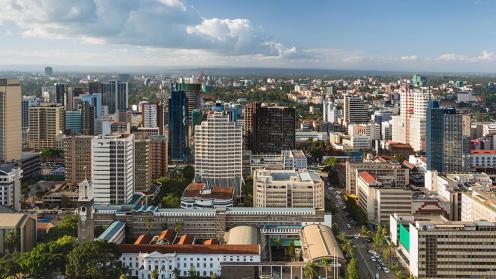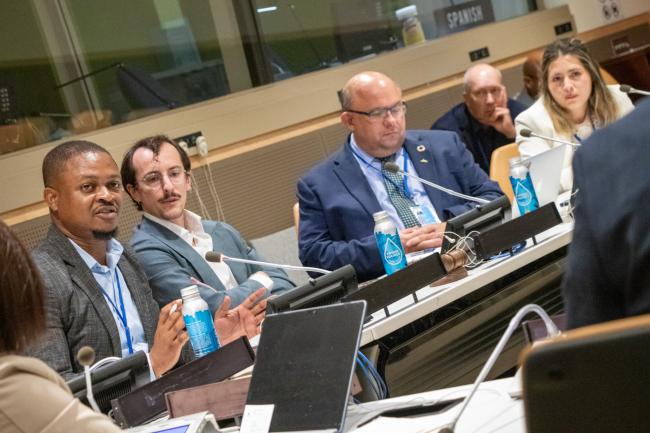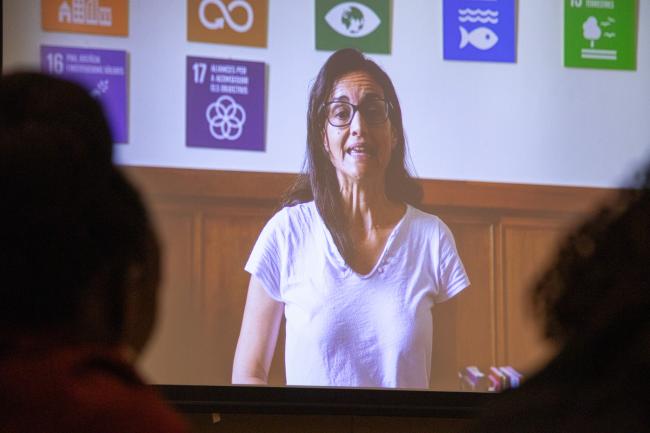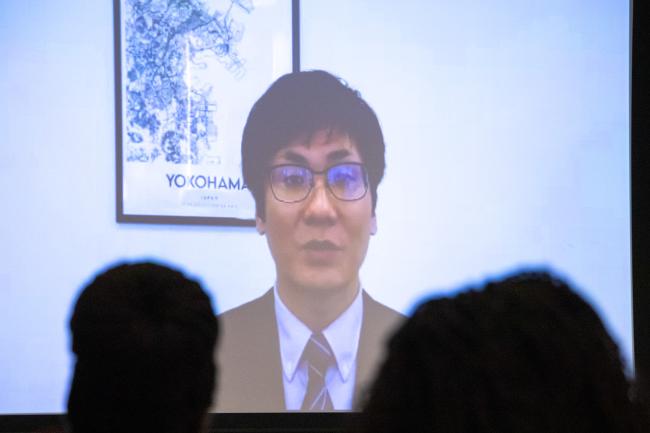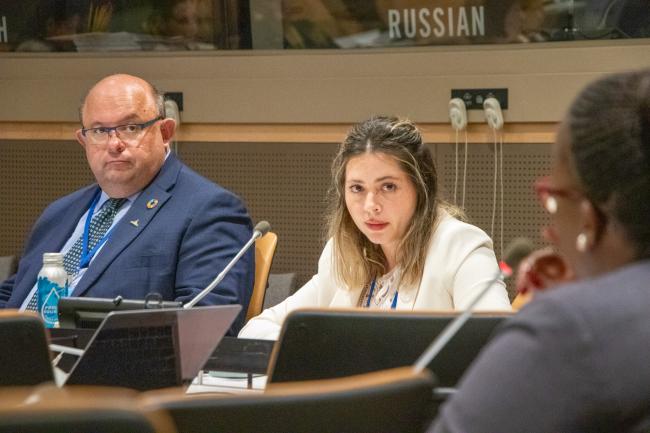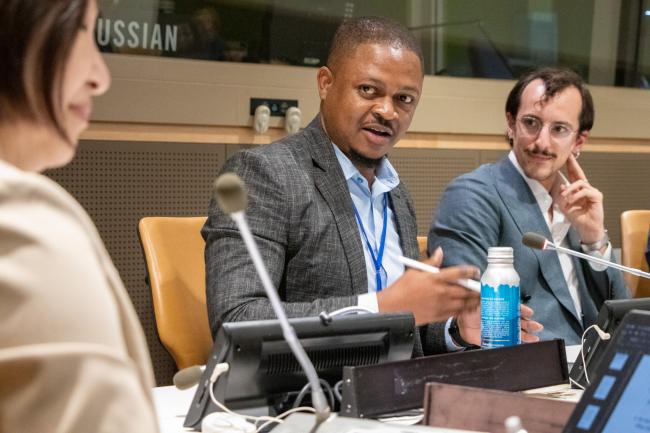About
City leaders at different stages of producing Voluntary Local Reviews—reports that measure local progress and challenges in reaching the Sustainable Development Goals—compared notes on lessons learned and how to maintain momentum after a VLR.
At the halfway point of the 2030 Agenda, several cities and regions have completed multiple Voluntary Local Reviews (VLRs)—progress reports on how their communities are either achieving or struggling to reach the Sustainable Development Goals (SDGs) and what those aspirational targets look like at their neighborhood level. As more cities embark on developing their first VLRs and identifying their own unique circumstances and priorities, the potential for pooling wisdom on effectively localizing SDG action is enormous.
This was one of many ideas exchanged between VLR veterans and newcomers during a panel discussion convened by the Institute for Global Environmental Strategies (IGES) and the International Institute for Sustainable Development (IISD) on 11 July 2023, at UN Headquarters. Occurring on the margins of the High-level Political Forum (HLPF) at the halfway point of the 2030 Agenda, the discussions frequently emphasized how many SDGs find their truest expression and achievement at the local level—making local governments the best agents to get the 2030 Agenda back on track.
Speaking via video message, Barbara Pons-Giner, Commissioner for Strategic Projects and the 2030 Agenda, Barcelona City Council, recalled how the VLR by New York City in 2018 reflected the SDGs as a crucial framework by progressive cities across the world. She noted that Barcelona’s creation of its first VLR built on the existing municipal planning work of its city council. While their team were able to directly adopt some of the global targets and corresponding indicators, she said they arrive at other local targets through bilateral agreements and found their main task was connecting dots and ensuring consistency of results across participating stakeholders. Over the course of the three VLRs that Barcelona has published, Pons-Giner said the city has tried to introduce new content—such as a budgetary alignment—while increasing citizen participation through open-source digital platforms and an annual SDG-themed awards gala. She highlighted that such efforts matter to combatting absurd criticisms ground in conspiracies while also engaging with healthy skepticism about the real social value of the SDGs.
Masahiro Nishikawa, Director of the Office of the City of Yokohama, Representative to the Americas, shared how creating Yokohama’s first VLR in 2021 and engaging with peers in the SDG Leadership Cities network led his team to recognize three essential aspects of the VLR process. First, they found the experience invaluable as a city management process, helping them improve the design of their urban initiatives for their 3.7 million residents. Secondly, they have found the VLR to be a powerful communication tool for sharing experiences and knowledge between cities. Finally, they found the creation of VLRs to be an aid to the global movement of city governments taking the leadership role of achieving the SDGs. In his video message, Nishikawa also outlined how Yokohama’s experience creating a VLR has informed some of their partnerships with other cities in Southeast Asia, such as Bangkok, Thailand and Da Nang, Viet Nam. He underlined that a VLR can be a valuable tool for urban development management in emerging cities, since it could allow the city to review projects comprehensively while attracting more green investment.
Mariana Cammisa, International Cooperation Manager, Buenos Aires City Government, said her government discovered its various city departments were already working toward 67 SDG targets when they created their first VLR in 2019—they simply articulated them differently before embracing the SDGs. While there were differences between departmental familiarity with tracking data—some had to learn what an indicator was while others had existing statistical teams—she noted Buenos Aires already had a strong data ecosystem that strengthened their appeals to officials to use the SDGs as a framework for crafting evidence-based, crosscutting policies. The process also revealed where there were data gaps. Cammisa shared how Buenos Aires' indicators for tracking gender equity grew from a narrow focus on physical autonomy and violence before the VLR to now include 90 indicators that cover physical, economic, and decision-making equality. With five VLRs complete at the end of the current city administration, she shared she is watching to see if the SDGs have been integrated enough into city norms to carry over into the new government.
The Mayor of Kitchener, Canada and Co-President of United Cities and Local Governance (UCLG), Berry Vrbanovic, recalled the advocacy efforts municipal and regional leaders launched when the 2030 Agenda and its SDGs were negotiated. He reported that their lobbying to have at least part of the Agenda dedicated to cities eventually led to the inclusion of SDG 11: Sustainable Cities and Communities. He said that, in his own city, the inclusion of the SDGs has been a gradual process of adding them to existing mechanisms, such as Kitchener’s regularly updated four-year strategic plan. While Kitchener’s first formal VLR is still on the horizon, he reported the municipal government has been able to advance the SDGs in other visible ways, such as the recently launched SDG Idea Factory—the first UCLG local action hub and a small business incubator focused on women-led businesses, businesses led by equity-seeking groups, and sustainability driven startups. Mayor Vrbanovic noted that through the rise of VLRs, the adoption of the SDGs by the Federation of Canadian Municipalities and the top-down efforts of the national government, more Canadian cities are navigating relationships with the 2030 Agenda, though Canada has done much better at embracing the SDGs at the college and university level.
Reynald Maeda, Executive Director, UN Association of Tanzania, shared the experience of Mwanza, Tanzania completing its first VLR—a “twin” reporting effort with Tampere, Finland that was prompted and facilitated by UN-Habitat. He said his team’s primary goal with their VLR was community engagement, a key element they found lacking in Voluntary National Reviews (VNR) and crucial to ensuring SDG efforts target communities and individuals furthest behind. Through Leave No One Behind community workshops, Maeda and his team tracked the priorities of Mwanza’s residents and worked to fit their measures of a meaningful life within the SDGs, rather than the other way around. Maeda also saw this first VLR as an experiment in how SDG reporting from one of Tanzania’s 186 local authorities could inform the country’s VNR as well as influence how municipal leaders and the central government track and finance policy areas. While he noted administrative data generated by health care facilities and schools exists, it is not well used or harmonized—an obstacle that all panelists said they encountered in their regions.
Martino Miraglia, Human Settlements Officer, SDG Localization and Local Governments, UN-Habitat, said he spoke “on behalf of the UN," but stressed that "it is cities that are driving this agenda.” He recalled efforts to ensure local governments were included when the 2030 Agenda was negotiated and shared several proof points that show municipalities are “owning” the SDGs: the more than 30 side events at this year’s HLPF based on SDG localization and VLRs; the modest increase in local governments joining national delegations; and the recent approval of the UN-Habitat Assembly resolution on the localization of the 2030 Agenda. He emphasized that the development of 220 VLRs at the local level is further evidence of cities championing the SDGs, but noted they represent a minute fragment of all local and regional governments. Beyond the challenge of reaching local governments that have not yet engaged with the SDGs, he emphasized the end point of a VLR must be the revision and strengthening of local planning. He added that an SDG progress report is just the first step in engaging political leadership and building up a data ecosystem that drives policies connected to stakeholder needs.
The side event was moderated by Yatsuka Kataoka, Programme Director, IGES, and Kyle Wiebe, Policy Advisor, IISD. A recording of the side event is available on IISD's YouTube channel.
To receive free coverage of global environmental events delivered to your inbox, subscribe to the ENB Update newsletter.
All ENB photos are free to use with attribution. For this side event, please use: Photo by IISD/ENB | Matt TenBruggencate.
